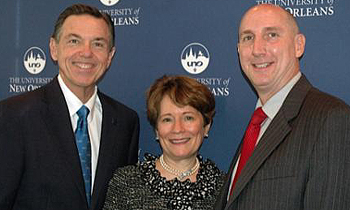Public Media Venture Group explores ATSC 3.0 project
As his new Public Media Venture Group project takes form, CEO Marc Hand said single-frequency networks will be an important part of the company’s work on the transition to the ATSC 3.0 digital TV system.
At PBS TechCon in Las Vegas, Hand announced PMVG is launching a pilot project in San Francisco to build out an SFN project to improve ATSC 3.0 reception across the Bay Area. Currently, broadcast viewers in the market depend on signals transmitted either from Sutro Tower in San Francisco or from Mount San Bruno just to the south. Those sites provide good coverage into San Francisco and Oakland, but mountainous terrain around the bay blocks clear reception of signals from public broadcaster KQED and other local stations in outlying areas.
Under the leadership of Erik Dausman, who presently heads the Sutro Tower transmitter site and will be a consultant to the project, the group plans to install lower-powered SFN transmitters at six additional sites around the Bay Area to help fill in those signal holes.
“SFNs provide a new platform for making stations’ signals much denser and more uniform,” Hand told Current. Broadcasters in the Bay Area have tried to resolve their signal issues by using on-channel boosters in analog and ATSC 1.0 digital, but those create interference issues. The ATSC 3.0 system will eliminate many of those problems, Hand said. Unlike analog and ATSC 1.0, the new system will function better with multiple signals on the same frequency, making SFN operation more technically feasible.
ATSC 3.0 will also function with mobile devices, another advantage over ATSC 1.0. But reliable mobile reception will also require strong signals, which will make SFNs essential in markets such as San Francisco, Hand says.
PMVG hopes to bring KQED into a partnership it is forging with local commercial stations to build and operate the SFN system. The partnership would mirror the existing Sutro Tower partnership that Dausman has led. KQED has been a longtime tenant of the multiple commercial station owners who built and operate the landmark tower and transmission facility, but it hasn’t yet committed to join it, Hand said.
The San Francisco project is fully financed from private sources, Hand said, though details of the financing aren’t being disclosed yet. PMVG plans to recoup the costs of the SFN installation from lease revenues from commercial stations that join the project, as well as from potential revenues to be earned by stations that provide data distribution over the spectrum.
In January, PMVG announced a partnership with Osborn Infrastructure, a commercial engineering firm, to build alliances such as SFNs with public and commercial stations nationwide. At TechCon, Hand said PMVG hopes the San Francisco test will lead quickly to similar projects elsewhere.
“We’re now looking at 20 to 25 other markets,” Hand said, including several in areas where SFNs could be built out statewide in partnership with state public TV networks. “We’re looking at what are available tower sites, what are the existing assets within each system that could be used,” he said.
PMVG will pay the initial costs of building out SFNs in each market, and then participating stations will share the ongoing operating expenses, including tower rental, transmitter maintenance and connectivity. Those costs will vary from market to market, Hand said. In some cases, public stations that take the lead in joining SFN ventures will pay reduced ongoing costs because they’ll be providing space on their own existing towers.
Looking ahead to some of ATSC 3.0’s other promises, Hand said public stations will advance their missions and enhance their bottom lines by using digital TV spectrum over SFNs for non-broadcast applications such as rural educational services, telemedicine and public safety.
PMVG is entering an already-crowded field that includes several groups led by commercial broadcasters. A partnership led by Pearl TV in Phoenix is already testing ATSC 3.0, with pubcaster KAET taking part. At the NAB Show in Las Vegas last week, Pearl TV’s “model market” group announced its own SFN testing with a second transmitter.
The Pearl TV partners and several large commercial TV groups, including Fox TV and Sinclair, also announced plans at the NAB Show to launch ATSC 3.0 broadcasts in 40 major markets by 2020.
This article has been updated with details about financing for build-out and operations of SFNs. It has also be corrected. An earlier version erroneously reported that Erik Dausman will be joining PVMG as a full-time staff member, but he will be a consultant to the project. It also mistakenly reported that KQED will be a partner in the San Franciso SFN, but the station has not yet committed to the project.







